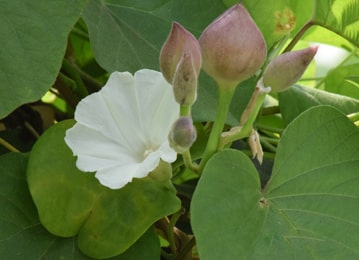Trivrit (Operculina turpethum) – Practical Uses, Benefits & Dosage

Description of Plant
It is a perennial aromatic creeper and exudes a milky juice. Stems are long, twinning, twisted, tough and brown. Leaves are many, small and oval in shape. Plant wears the white flowers which are 1 to 4 inch long and has 3 to 4 branches. Fruits are round in shape and consists of shiny 2 inch long seeds. Roots are thick, branched and black in color. Roots are black in color, long, slender, fleshly and much branched. The plant wears the fruits and flowers in March to December.
General Information
In Ayurveda, Trivrit is placed in the category of very useful herbs. This herb is packed with the purgative properties hence it helps to remove toxins from the body. This herb is loaded with the antipyretic and anti-inflammatory properties. Use of this herb is quite good in the liver disorders as it helps in the cleaning of stomach. The herb is good in the various problems like flatulence, constipation, hemorrhoids and improper bowel movements.
The root bark contains glycosidium resin which is 10%. It also contains a glycoside named as turoethin which has purgative action. Except this it also contains two glycosides, volatile oils which also possesses the therapeutic properties.
Classification
- Kingdom: Plantae
- Division: Magnoliophyta
- Class: Magnoliopsida
- Order: Solanales
- Family: Convolvulaceae
- Genus: Operculina
- Species: O. turpethum
Habitat
This herb is commonly found on the roadsides across India. It is perennial herbaceous, hairy vine growing 4 to 5 meter in length, endemic to India. The herb is commonly found in North Circars and Deccan region up to 3000 ft.
Names
- Latin Name – Operculina turpethum
- Sanskrit Synonyms – Tribhandi, Triputa, Trivrit, Sarala, Suvaha, Rechani, Ardhachandra, Kumuda Gandhini.
- English Name – India Jalap, Saint Thomas Lidpod, Trasparent wood rose, Turpeth root
- Hindi Name – Nisoth, Panila, Pithori
- Telugu Name – Tegade
- Bengali Name – Tevudi
- Marathi Name – Nisottar, Nishottar
- Gujarathi Name – Nasttara
- Tamil Name – Sivadai, Adimbu, Kumpncan, Paganrai
- Malayalam Name – Chivaka
- Kannada Name – Vilitigada, Aluthi gida, Bangada balli, Bilitigade, Devadanti, Nagadanti
Ayurvedic Properties
| Hindi / Sanskrit | English | ||
| Rasa | Tikta, Katu | Taste | Bitter, Pungent |
| Guna | Laghu, Rooksha, Teekshna | Physical Property | Light, dry, Piercing |
| Virya | Ushna | Potency | Hot |
| Vipaka | Katu | Metabolic Property (After Digestion) | Pungent |
Effects on Doshas
It balances Pitta and Kapha dosha. Also increases Vata dosha.
Classical Categorization
| Charak Samhita | Sushruta Samhita | Vagbhata |
|
|
|
Ancient Verse about Operculina turpethum

The Bhavprakash nighantu, edition of 2010: verse 193-194, page no-397-398.
Shweta trivrit, Tribhandi, Trivrita, Triputa, Sawrnabhuti, Sarla, Nishotra and Rechani are the different names of trivrit. It is pungent, sweet, hot in potency, dry, manages vataj and pittaj fever, inflammation and abdominal disorders.
References:-
The Bhavprakash nighantu with elaborated Hindi commentary by Padmashri prof. K.C.Chunekar, edited by Dr. G.S. Pandey: verse 193-194, edition of 1998: page no- 397-398.
Practical Uses of Operculina turpethum
- This herb is loaded with the cleaning and purgative properties. It helps in easy passage of stool and also increases the bowel movements. The herb helps to prevent the constipation also.
- Use of this herb is quite good to resolve problem of hemorrhoids. It helps to provide relief in the symptoms associated with hemorrhoids like itching, irritation, redness, soreness and swelling around anus.
- This is known to a good herb in the treatment of edema as it helps to expel out the extra water from body. Furthermore, it helps to manage the symptoms like puffiness or swelling of tissues under skin, increase in abdomen size and stretched skin.
- The herb also supports the good health of liver. It helps in the cleaning of liver by removal of toxins.
- Purgative action of this herb is quite beneficial in various stomach disorders like flatulence, indigestion and unsatisfactory bowel movements etc.
- This herb also helps to maintain the healthy cholesterol levels in body.
- Being purgative in nature, use of this herb is quite good in the arthritis and osteoarthritis. It helps to reduce the inflammation and swelling in joints. Moreover its anti- inflammatory properties help in the pain reduction.
- This herb is packed with the Anti-diabetic properties which helps to maintain the healthy blood sugar levels in the body. Moreover, this herb also helps to manage the symptoms which are associated with diabetes like fatigue, increased urination, weight loss, excessive thirst, blurred vision and slow healing of the wounds.
- Being anti-pyretic in nature, it helps to provide relief in the fever.
- Use of this herb is quite beneficial in the treatment of respiratory complications like cough, bronchitis, dyspnea, pneumonia and tuberculosis. It helps in the clearance of mucous from air channels. The herb also provide relief in shortening of breath, lungs congestion, nasal congestion and cough.
- Blood purification properties of this herb are quite effective in the treatment of skin diseases. It helps to provide relief in the symptoms which are associated with skin diseases like itching, burning sensation, redness and oozing etc.
- This herb possess the Anthelmintic properties which helps in clearing of intestinal worms from body. Hence the use of this herb is quite effective in the treatment of various intestinal infections which are caused by bacteria, virus, protozoa and various other pathogens which may lead to serious digestive problems like cholera.
- The anti-inflammatory properties of this herb help to provide relief in the bodyache.
Parts Used
Roots, Bark, Leaves.
Dosage
Powder 1-3 grams in divided dose per day.



